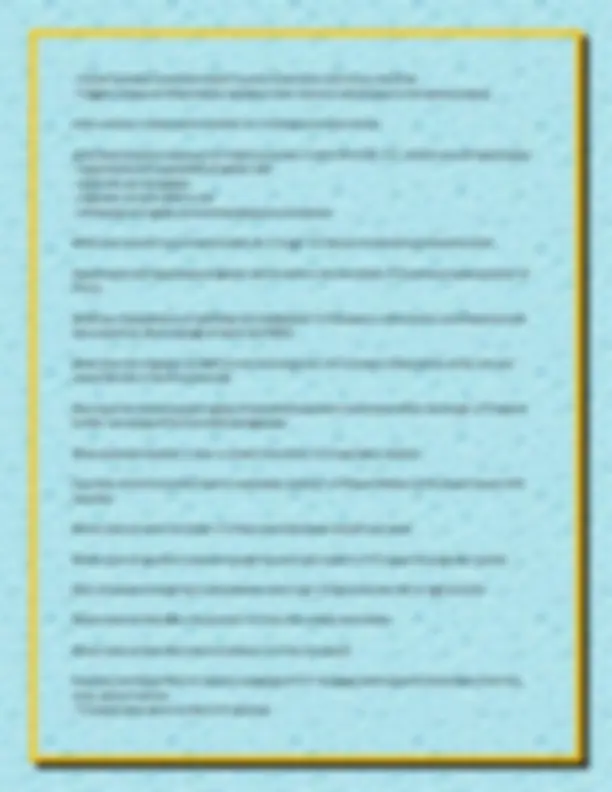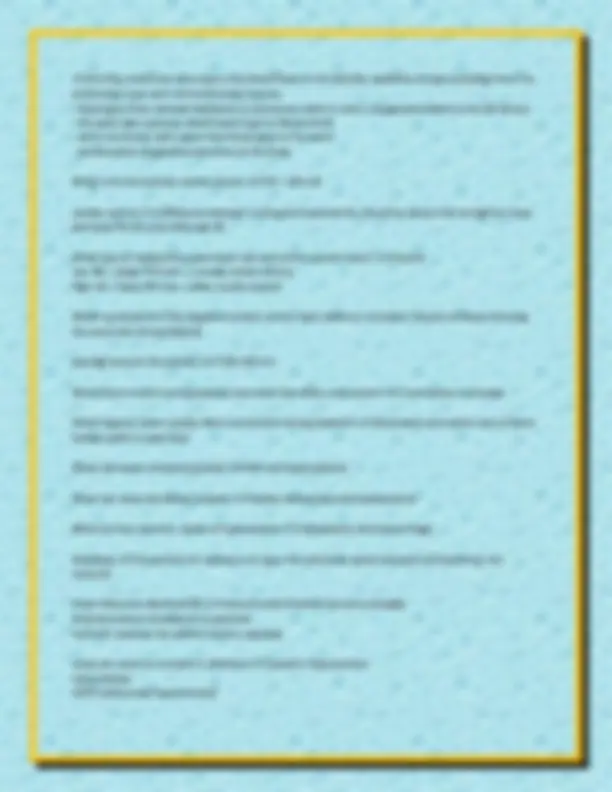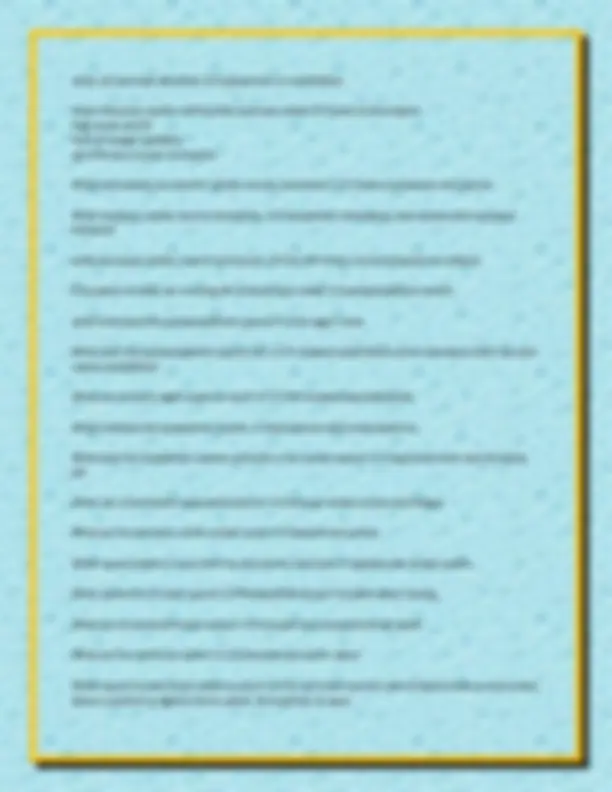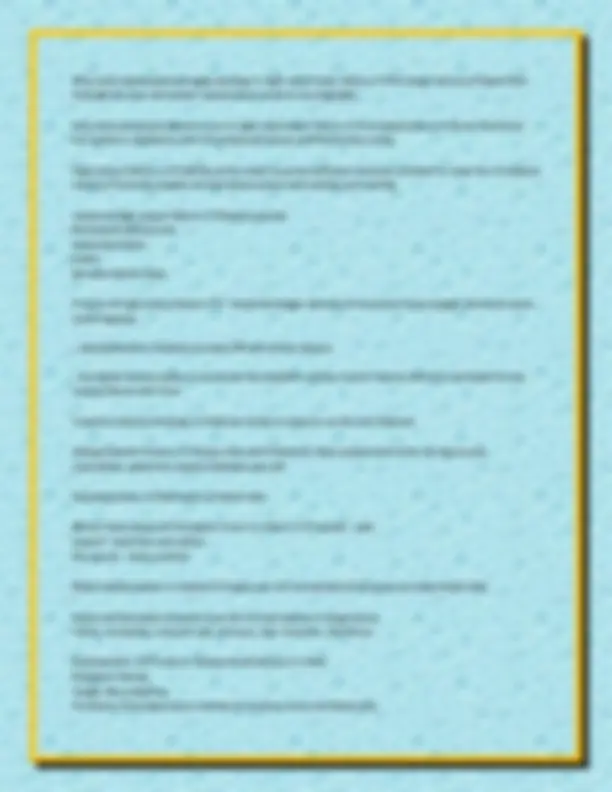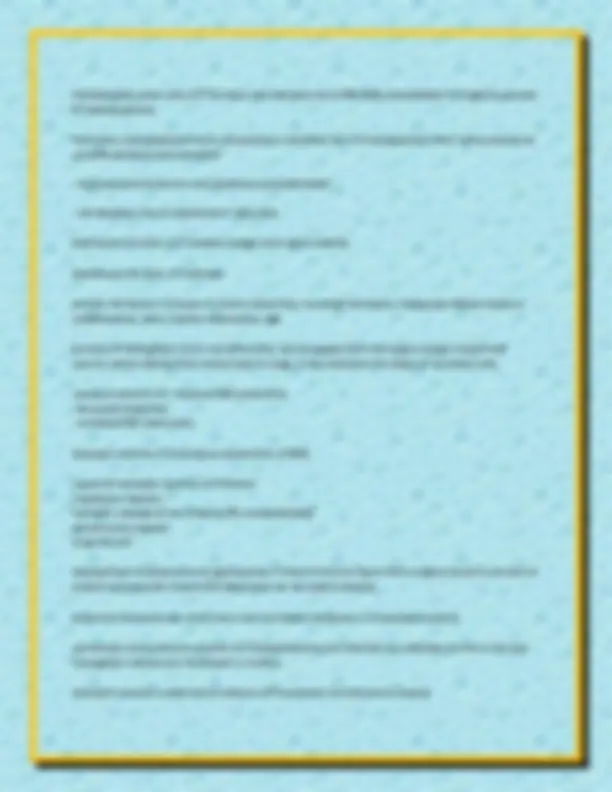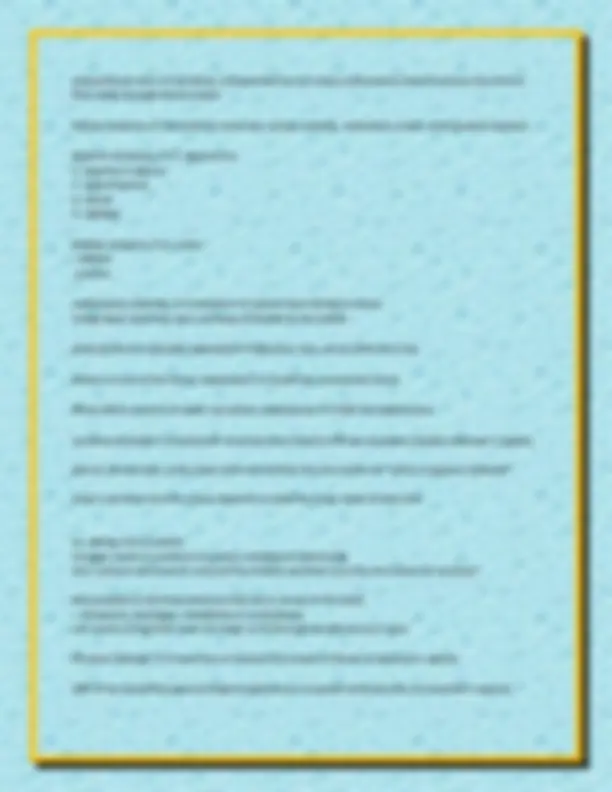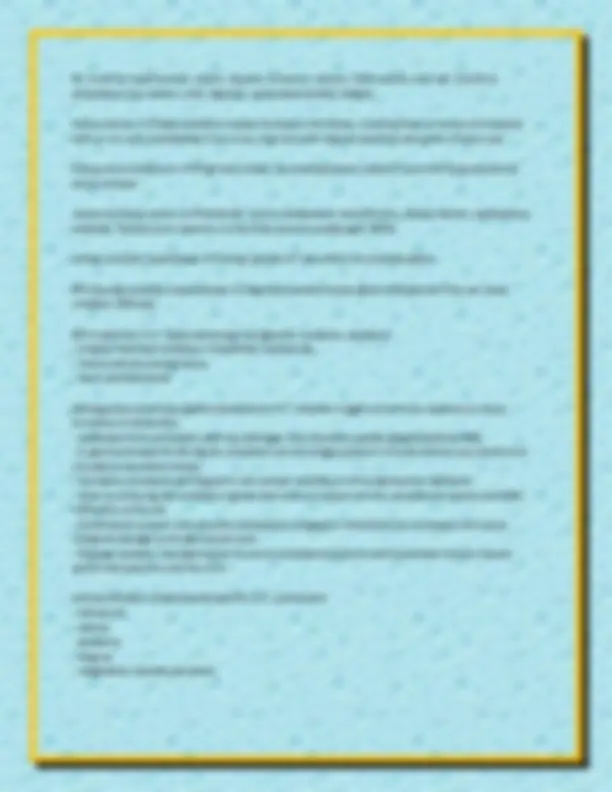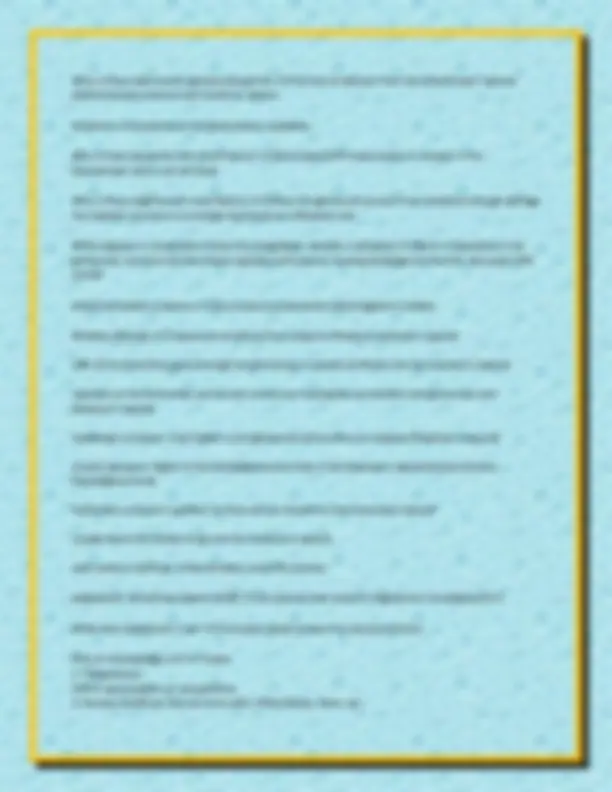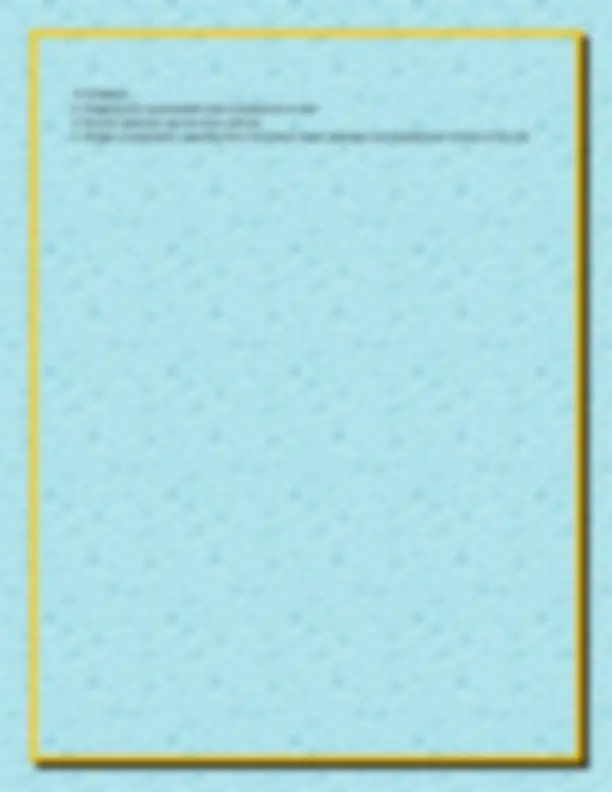Download NR 507: Advanced Pathophysiology Midterm and more Exams Nursing in PDF only on Docsity!
NR 507: Advanced Pathophysiology Midterm Asthma ✔✔Chronic disease due to bronchoconstriction and an excessive inflammatory response in the bronchioles What are 5 s/s of asthma ✔✔coughing wheezing shortness of breath rapid breathing chest tightness Pathophysiology of asthma (5) ✔✔-airway inflammation, bronchial hyper-reactivity and smooth muscle spasm
- excess mucus production and accumulation
- hypertrophy of bronchial smooth muscle
- airflow obstruction
- decreased alveolar ventilation Bronchioles ✔✔smaller passageways that originate from the bronchi that become the alveoli 3 layers of the bronchioles ✔✔innermost layer middle layer - lamina propria outermost layer lamina propria ✔✔the middle layer of the bronchioles structure of the lamina propria ✔✔embedded with connective tissue cells and immune cells purpose of the lamina propria ✔✔white blood cells are present to help protect the airways How does the lamina propria effect the lungs in regards to asthma ✔✔the WBCs protective feature goes into overdrive causing an inflammatory response that damages host tissue What does the innermost layer of the bronchioles contain ✔✔columnar epithelial ells and mucus producing goblet cells What does the outermost layer of the bronchioles contain ✔✔smooth muscle cells what does the outermost layer of the bronchioles do ✔✔control the airways ability to constrict and dilate alveolar hyperinflation ✔✔When air is unable to move out of the alveolar like it should due to bronchial walls collapsing around possible mucus plug thus trapping air inside
how does hyperinflation occur? ✔✔the ongoing inflammatory process of asthma produces mucus and pus plug that the bronchial walls collapse around Effect of hyperinflation of the alveolar ✔✔-expanded thorax and hypercapnia (retention of CO2)
- respiratory acidosis What are two anticholinergic drugs used for asthma ✔✔tiotropium and ipratropium What do anticholinergics do in the lungs? ✔✔These drugs block the effects of the parasympathetic nervous system
- increasing bronchodilation MOA of anticholinergic drugs for asthma ✔✔the parasympathetic system is stimulated by the vagal nerve to release acetylcholine which binds to the cholinergic receptors of the respiratory tract to cause bronchial constriction = decreased airflow
- blocking the cholinergic receptors prevents acetylcholine binding preventing the bronchial constriction bronchitis ✔✔inflammation of the bronchial tubes 3 characteristics of bronchitis ✔✔bronchial inflammation hypersecretion of mucus chronic productive cough for at least 3 consecutive months for at least 2 successive years Perfusion ✔✔The supply of oxygen to and removal of wastes from the cells and tissues of the body as a result of the flow of blood through the capillaries. results of chronic bronchitis/ low perfusion ✔✔cyanosis right to left shunting chronic hypoxemia Why is there cyanosis with chronic bronchitis ✔✔there is hypoxia due to unfavorable conditions for gas exchange Right to left shunting ✔✔when blood passes from the right ventricle through the lungs and to the left ventricle without perfusion Causes of bronchitis ✔✔-long term exposure to environmental irritants
- repeated episodes of acute infection (RSV infection in early infancy)
- Factors affecting gestational childhood lung development (preterm birth) Pathogenesis of bronchitis ✔✔-Exposure to airborne irritants
- Pulmonary semilunar valve opens and blood flows to the alveolar capillaries for gas exchange from the pulmonary trunk and L & R pulmonary arteries
- blood goes from alveolar capillaries to pulmonary veins to return oxygenated blood to the left atrium
- bicuspid valve opens to allow blood to go to left ventricle
- aortic semilunar valve opens and blood goes to the aorta
- aorta pushes oxygenated blood out to the body What is the formula for cardiac output ✔✔CO = HR x SV cardiac reserve ✔✔difference between resting and maximal CO; should be about 4-5x as high but does decrease 1% per year after age 30 What type of relationship does heart rate and stroke volume have? ✔✔inverse low HR = longer fill time = increase stroke volume high HR = lower fill time = lower stroke volume What is preload? ✔✔the degree of stretch on the heart before it contracts/ amount of blood entering the ventricles during diastole average amount of preload? ✔✔ 120 - 130 mls When fibers stretch during diastole how does that effect contraction? ✔✔contraction is stronger What happens when cardiac fibers overstretch during diastole? ✔✔decreased contraction due to fibers being unable to snap back What can cause increased preload ✔✔CHF and hypervolemia What can cause decreased preload ✔✔cardiac tamponade and hypovolemia What are two common causes of hypovolemia ✔✔dehydration and hemorrhage Afterload ✔✔the amount of resistance to open the semilunar valves and eject of blood from the ventricle what influences afterload (3) ✔✔ventricle wall thickness (muscle strength) arterial pressure (resistance to ejection) ventricle chamber size (blood volume capacity) what can cause an increase in afterload ✔✔systemic hypertension valve disease COPD (pulmonary hypertension)
what can decrease afterload ✔✔hypotension or vasodilation what influences cardiac contractility (inotropic state) ✔✔levels of electrolytes High levels of ATP level of oxygen available synchronous muscle contraction What electrolytes are used for cardiac muscle contraction? ✔✔sodium potassium and calcium What increases cardiac muscle contraction ✔✔sympathetic stimulation; fear anxiety and increased thyroxine what decreases cardiac muscle contraction ✔✔low ATP levels; ischemia hypoxia or acidosis Stimulation of what set a resting HR (chronotropic state) ✔✔parasympathetic system what stimulates the parasympathetic system ✔✔the vagus nerve What does the parasympathetic system do? ✔✔It releases acetycholine which decreases heart rate and causes vasodilation What can extreme vagal response result in? ✔✔life threatening bradycardia What mediates the sympathetic system ✔✔epinephrine and norepinephrine What does the sympathetic system promote in the cardiac system ✔✔vasoconstriction and increased HR What can uncontrolled tachycardia lead to? ✔✔reduced stroke volume and fatigue What are the two parts of the cardiac cycle? ✔✔diastole and systole What causes blood to move from the atria to the ventricles ✔✔gravity and atriole systole What causes the S1 heart sound? ✔✔Bicuspid/Mitral and Tricuspid valves closing What are the atrioventricular valves? ✔✔tricuspid and bicuspid (mitral) valves What are the semilunar valves? ✔✔pulmonary and aortic valves What causes the semilunar valves to open? ✔✔As ventricles contract and intraventricular pressure rises, blood is pushed up against the SL valves, forcing them to open
- damage causes reduced ejection fraction and left ventricle gets tired and becomes unable to eject normal amount of blood
- increased amount of blood remaining in left ventricle and increased left ventricle preload causes the left atrium unable to eject the normal amount of blood into the left ventricle
- blood volume and pressure backs up into the pulmonary veins
- increased pressure will force fluid from the pulmonary capillaries into the pulmonary tissues What does fluid in the pulmonary tissue result in ✔✔the areas are flooded and results in pulmonary edema and dyspnea cor pulmonale ✔✔right-sided heart failure right sided heart failure ✔✔inability of the right ventricle to provide adequate blood flow into the pulmonary circulation Causes of right sided heart failure ✔✔- pulmonary disease
- pulmonary hypertension
- RV MI
- RV Hypertrophy
- pulmonary SLV or tricuspid valve damage
- secondary to left heart failure What is the most common cause of right sided heart failure ✔✔pulmonary hypertension Progression of right sided heart failure ✔✔- damage causes the right ventricle to increase contraction force to eject/unload the blood
- over time EF is reduced and right ventricle us unable to eject the normal amount of blood
- the blood remaining in the RV increases and RA preload increases until the RA is unable to eject the normal amount of blood into the RA
- the amount of blood remaining in the right atrium increases causing an increase in RA preload
- blood volum enad pressure then backs up into the vena cava and systemic veins signs and symptoms of right sided heart failure ✔✔jugular vein distension hepatosplenomegaly peripheral edema
Why does hepatosplenomegaly develop in right sided heart failure ✔✔the large volume of blood flow through the liver and spleen causes these areas to be engorged why does peripheral edema occur in right sided heart failure ✔✔Increased pressure forces fluid from the systemic capillaries into the peripheral tissues and flood those areas High output failure ✔✔inability of the heart to pump sufficient amounts of blood to meet the circulatory needs of the body despite normal blood volume and cardiac contractility causes of high output failure ✔✔Severe anemia Nutritional deficiencies Hyperthyroidism Sepsis Extreme febrile state Process of high output failure ✔✔- impaired oxygen delivery of excessive tissue oxygen demands cause tissue hypoxia
- catecholamines initiation increase HR and stroke volume
- increased cardiac output is produced but depletes cardiac muscle reserve overtime and leads to low output failure over time Troponin-Calcium Binding ✔✔Calcium binds to troponin on the thin filament sliding filament theory ✔✔theory that actin filaments slide toward each other during muscle contraction, while the myosin filaments are still Hematopoiesis ✔✔formation of blood cells Where does blood cell formation occur in a fetus ✔✔3 weeks - yolk week 8 - fetal liver and spleen 5th month - bone marrow Blood cell formation in chidren 0-5 years old ✔✔red marrow of all bones to make blood cells blood cell formation in adults over 20 ✔✔red marrow in large bones
- illium, vertebrae, cranium, jaw, sternum, ribs, humerus, and femur Erythropietin ✔✔Produce: Kidney (small amount in liver) Released: Kidney Target: Bone Marrow Functions: Stimulates bone marrow to produce more red blood cells
polycythemia vera ✔✔condition characterized by too many erythrocytes; blood becomes too thick to flow easily through blood vessels Kidney Anatomy ✔✔renal artery renal vein cortex, medulla, renal pelvis ureter renal pyramid nephron Nephron Anatomy ✔✔1. glomerulus
- bowman's capsule
- collecting duct
- tubule
- capillary Bladder anatomy ✔✔- ureter
- bladder
- urethra reabsorption (kidney) ✔✔movement of solutes from filtrate to blood things taken back that were secreted of filtered by the kidney what solutes are typically reabsorbed ✔✔glucose, ions, amino acids and urea Where is most of the solute reabsorbed? ✔✔proximal convoluted tubule What effects amount of water and solute reabsorption ✔✔ADH and aldosterone secretion (kidney) ✔✔movement of solutes from blood to filtrate anywhere besides bowman's capsule able to secrete salts, acids, bases and urea directly into the tubule via active or passive transport what is secreted into the tubule depends on what the body needs at that time ex. eating a lot of protein nitrogen waste is a product of protein metabolism (ammonia) liver converts ammonia to urea and the kidneys secreted urea into the tubule for secretion also possible to eliminate products that are in excess in the blood -- potassium, hydrogen, metabolites or medications can secrete things that were too larger to fit through the glomerulus's pore filtration (kidney) ✔✔movement of solutes from blood to filtrate at bowman's capsule 20% of the blood that goes through the glomerulus is passed as filtrate into the bowman's capsule
depends on the hydrostatic and oncotic pressures/ starling forces between the glomerulus and bowman's capsule hydrostatic pressure: a lot higher in the glomerulus (move into the nephron/bowman's capsule) oncotic pressure: higher in the blood/glomerulus than in the bowman's capsule (move into the blood/glomerulus) hydrostatic pressure is greater so there will be movement into bowman's capsule usually favors the filtrate to go into the bowman's capsule each persons full body is filtered about every 40 minutes Conditions associated with renal failure ✔✔- congenital abnormalities in the urethral tract development
- kidney and bladder cancer
- infections
- glomerulonephritis
- acute/ tubular necrosis
- AKI vesicoureteral reflux ✔✔Abnormal ureter-bladder connection allowing retrograde flow of urine from bladder to ureters and/or kidneys renal agenesis ✔✔unilatral or bilateral failure of the kidneys to develop in utero Potter syndrome ✔✔Syndrome characterized by bilateral renal agenesis and incompatibility of live birth Wilms tumor ✔✔- Embryonal kidney tumor associated with defective tumor (WT) genes
- Tumors are typically not clinically diagnosable until age 1-5 even though they are present at birth polycystic kidney disease ✔✔- Mutant PKD genes cause fluid accumulation in kidney tubules "cysts"
- The cysts can be the size of grapes or oranges and compress and destroy nephrons Why are kidneys and bladders at high risk for cancer ✔✔- UT is the route of excretion for many toxins and contains highly mitotic cells Descending infection ✔✔The blood can carry bacteria from a focus of infection in another part of the body to the kidneys. The bacteria then pass with the urine down the ureters to the bladder. Ascending infection ✔✔- urethra to bladder, and then to kidney
- due to: bacteria from residual fecal contamination
Rx: meds for hypertension, statins, epoetin, diuretics, calcium, LOW protein, low salt, restrict K, phosphorus (no chicken, milk, legumes, carbonated drinks), dialysis. kidney stones ✔✔Solid crystalline masses formed in the kidney, resulting from an excess of insoluble salts or uric acid crystallizing in the urine; may become trapped anywhere along the urinary tract. kidney stone treatment ✔✔high fluid intake, decreasing dietary intake of stone-forming substances, stone removal causes of kidney stones ✔✔Family HX, chronic dehydration and infection, dietary factors, medications, imobility. Stoned more common in men than women usually ages 30/50. benign prostatic hyperplasia ✔✔benign growth of cells within the prostate gland BPH (benign prostatic hyperplasia) ✔✔Age-associated prostate gland enlargement that can cause urination difficulty. BPH treatment ✔✔- Alpha-adrenergic antagonists: terazosin, doxazosin
- 5 - alpha reductase inhibitors: finasteride, dutasteride
- Transurethral prostatectomy
- Open prostatectomy pathogenesis of primary glomerulonephritis ✔✔- infection triggers of immune response to cause formation of antibodies
- antibodies form complexes with the pathogen that should be rapidly phagocytized by WBC
- in glomerulonephritis the Ag-Ab complexes are not phagocytized in a timely manner and continue to circulate in the blood stream
- the Ag-Ab complexes get trapped in the narrow vasculature of the glomerular capillaries
- build up of the Ag-Ab complexes signals that immune system and the complement system and WBC infiltration of the site
- Complement protein with enzymes released by phagocytic cells attack the complexes and cause collateral damage to the glomerular area
- Damage weakens thee glomerular structure and plasma proteins with blood leak into the tubular system and pass out into the urine clinical indicators of glomerulonephritis ✔✔- proteinuria
- hematuria
- edema
- azotemia
- oliguria
- coagulation cascade activation
Why is there edema with glomerulonephritis ✔✔the loss of albumin from the bloodstream reduces plasma oncotic pressure and results in edema Azoetmia ✔✔presence of elevated plasma creatinine Why is there azoetmia with renal failure? ✔✔Decreased GFR means waste is remains in the bloodstream and is not excreted Why is there oliguria with renal failure? ✔✔when the glomerual structure has sustained enough damage the nephron structure is no longer functional as a filtration unit What happens in renal failure when the coagulation cascade is activated ✔✔fibrin is deposited in the glomerular structure and decreases capillary perfusion by causing blockages and further decreases GFR further blood hydrostatic pressure ✔✔the pressure produced by a fluid against a surface filtration (kidney) ✔✔movement of solutes from blood to filtrate at bowman's capsule 20% of the blood that goes through the glomerulus is passed as filtrate into the bowman's capsule depends on the hydrostatic and oncotic pressures/ starling forces between the glomerulus and bowman's capsule hydrostatic pressure: a lot higher in the glomerulus (move into the nephron/bowman's capsule) oncotic pressure: higher in the blood/glomerulus than in the bowman's capsule (move into the blood/glomerulus) hydrostatic pressure is greater so there will be movement into bowman's capsule usually favors the filtrate to go into the bowman's capsule each persons full body is filtered about every 40 minutes angiotensin converting enzyme (ACE) ✔✔an enzyme that converts angiotensin I to angiotensin II What does angiotensin II do? ✔✔increases blood pressure by vasoconstriction Role of macrophages ✔✔-In Innate:
- Phagocytosis PRR or opsonization w/ complement
- Secrete Cytokines: Recruit more cells, inflammation, fever, etc.

